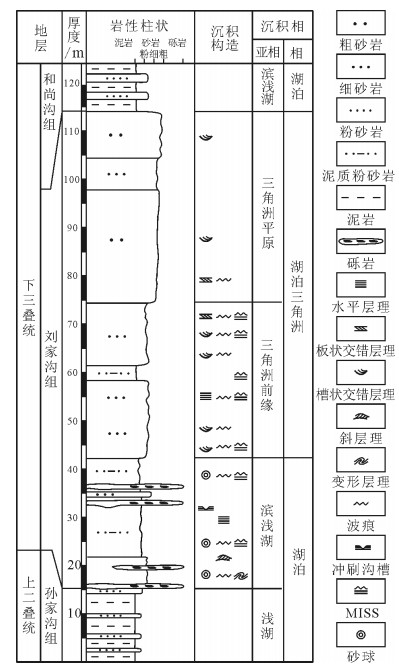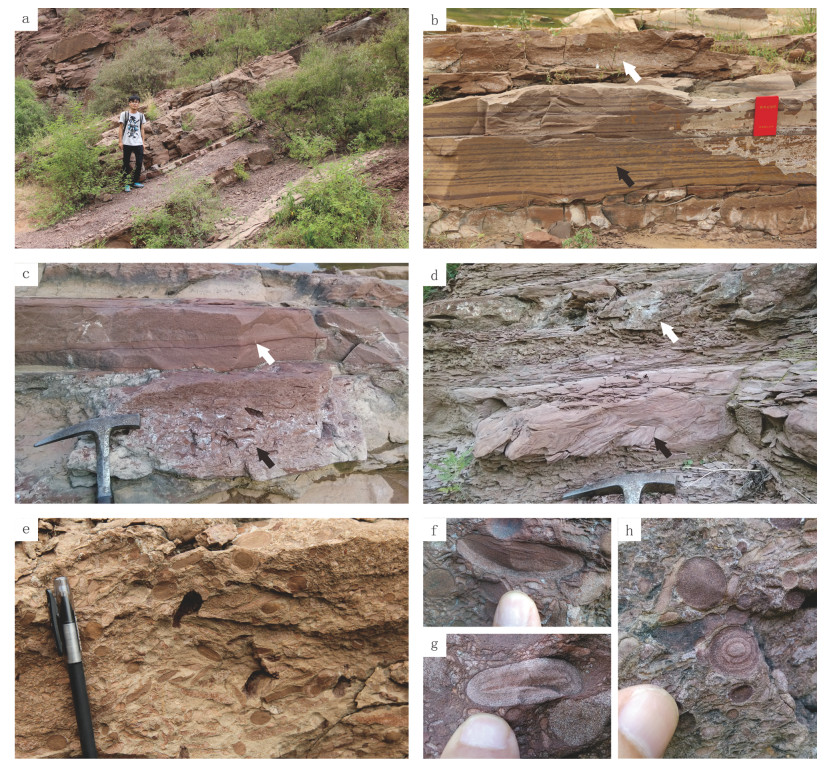The genesis of conglomerate in Lower Triassic Liujiagou Formation of western He'nan Province
-
摘要:
豫西地区刘家沟组中下部发育多层砾岩,其中扁平砾石与球形砾石共生,扁平砾多顺层排列,球形砾常具圈层结构。因该砾岩层发育普遍,特征明显,成为刘家沟组的区域划分对比标志之一。但迄今为止,其成因众说纷纭、未有定论。通过砾岩发育层段的野外观察,结合刘家沟组的沉积环境分析,认为宜阳地区刘家沟组砾岩层的砾石不是单纯的物理成因,其形成可能与微生物繁盛的席底底质有关。微生物席的存在使沉积物表面具有一定的粘性和韧性,在动荡水流的作用下,部分破坏作用形成的微生物席碎片卷曲、滚动,形成具有圈层结构的“砂球”,在湖泊重力流作用下,扁平的微生物席碎片与“砂球”被搬运至较深水区域,形成特征明显的扁平砾石砾岩层。
Abstract:There are several layers of conglomerates in the Lower Triassic Liujiagou Formation in western He'nan Province.The con-glomerates consist of flat sand or mud gravels and round sand gravels, with some of the sand gravels having ring structures just like ooids in limestone.This obvious characteristic has become one of the important marker beds in dividing and correlating strata in the study area, though its cause remains a mystery and should be further ascertained.Based on the study of lithofacies of outcrops and lab experiments, the authors hold that the rings in gravels are microbially mediated structures, and the formation of conglomerates was probably associated with mats substrate after the Mass Extinction.Mat living caused the surface of sediments to have some viscosity and toughness, some destroying mat fragments caused curling, rolling and the development of "sand ball" with ring structure in vibrat-ing water, and those mat fragments and sand balls were transported into deeper water by lake gravity flow later, forming the obvious conglomerates in Liujiagou Formation of Lower Triassic in western He'nan Province.
-
Key words:
- western He'nan /
- Lower Triassic /
- Liujiagou Formation /
- sandball structure /
- conglomerate
-

-
[1] 陈世悦.华北地块南部晚古生代-三叠纪盆山耦合关系[J].沉积与特提斯地质, 2000, 20(3):37-43. http://www.cnki.com.cn/Article/CJFDTOTAL-TTSD200003006.htm
[2] 彭兆蒙, 吴智平.华北地区三叠纪地层发育特征及原始沉积格局分析[J].高校地质学报, 2006, 12(3):343-352. http://www.cnki.com.cn/Article/CJFDTOTAL-GXDX200603007.htm
[3] 赵小明, 童金南, 姚华舟, 等.华南早三叠世错时相沉积及其对复苏期生态系的启示[J].中国科学(D辑), 2008, 38(12):1564-1574. doi: 10.3321/j.issn:1006-9267.2008.12.010
[4] 赵小明, 牛志军, 童金南, 等.早三叠世生物复苏期的特殊沉积——"错时相"沉积[J].沉积学报, 2010, 28(2):314-323. http://cdmd.cnki.com.cn/Article/CDMD-10491-2010250465.htm
[5] Sepkoski J J, Bambach R K, Droser M L. Secular changes in Pha-nerozoic event bedding and the biological imprint[C]//Einsele G, Ricken W, Seilacher A, et al. Cycles and Events in Stratigraphy. Ber-lin:Springer-Verlag, 1991:298-312.
[6] Chu D, Tong J, Song H, et al. Early Triassic wrinkle structures on land:stressed environments and oases for life[J]. Scientific Reports, 2015, 5:10109. doi: 10.1038/srep10109
[7] 张利伟, 杨文涛, 牛永斌.河南宜阳地区陆相二叠系-三叠系界线附近微生物成因沉积构造特征及意义[J].地质论评, 2014, 60(5):1051-1060. http://www.cnki.com.cn/Article/CJFDTOTAL-DZLP201405011.htm
[8] Schieber J. Microbial mats in the siliciclastic rock record:a summary of diagnostic features[C]//The Precambrian earth:tempos and events. Amsterdam, Elsevier, 2004:663-673.
[9] Schieber J, Bose P K, Eriksson P G, et al. Atlas of microbial mat fea-tures preserved within the siliciclastic rock record[M]. 1st ed. Ox-ford:Elsevier, 2007:324.
[10] 梅冥相.陆源碎屑岩中微生物诱发的沉积构造的成因类型及其分类体系[J].地质论评, 2011, 57(3):419-436. http://www.cnki.com.cn/Article/CJFDTOTAL-DZLP201103013.htm
[11] Bouougri E, Porada H. Mat-related features from the Neoprotero-zoic Tizin-Taghatine group, Anti-Atlas belt, Morocco[C]//Atlas of Microbial Mat Features Preserved within the Siliciclastic Re-cord. Atlasesin Geoscience, 2007, 2:198-207.
[12] 梅冥相, 高金汉, 孟庆芬.从席底构造到第五类原生沉积构造:沉积学中具有重要意义的概念[J].现代地质, 2006, 20(3):413-422. http://www.cnki.com.cn/Article/CJFDTOTAL-XDDZ200603007.htm
[13] Pflueger F. Matground structures and redox facies[J]. Palaios, 1999, 14(1):25-39. doi: 10.2307/3515359
[14] Seilacher A. Biomat-related lifestyles in the Precambrian[J]. Palaios, 1999, 14(1):86-93. doi: 10.2307/3515363
[15] 梅冥相.微生物席沉积学:一个年轻的沉积学分支[J].地球科学进展, 2011, 26(6):586-597. http://www.cnki.com.cn/Article/CJFDTOTAL-DXJZ201106003.htm
[16] 梅冥相, 刘智荣, 孟庆芬, 等.南口虎峪中元古界大红峪组混积岩系的层序地层划分——海侵砂岩中的微生物席碎片简介[J].地质科技情报, 2007, 26(1):33-40. http://www.cnki.com.cn/Article/CJFDTOTAL-DZKQ200701006.htm
[17] Eoff J D. Suspected microbial-induced sedimentary structures (MISS) in Furongian (Upper Cambrian; Jiangshanian, Sunwaptan) strata of the Upper Mississippi Valley[J]. Facies, 2014:1-14. https://pubs.er.usgs.gov/publication/70116320
[18] Noffke N. Microbially-induced sedimentary structures (MISS) of Early and Middle Archaean Ages-Moodies Group, Pongola Super-group, Witwatersrand Supergroup (South Africa)[C]//Atlas of Mi-crobial Mat Features Preserved Within the Siliciclastic Rock Re-cord. Atlases in Geoscience, 2007, 2:153-157.
[19] 高红灿, 郑荣才, 魏钦廉, 等.碎屑流与浊流的流体性质及沉积特征研究进展[J].地球科学进展, 2012, 27(8):815-827. http://www.cnki.com.cn/Article/CJFDTOTAL-DXJZ201208000.htm
[20] Reading H G. Sedimentary environments:processes, facies and stra-tigraphy[M]. John Wiley & Sons, 2009.
[21] 李林, 曲永强, 孟庆任, 等.重力流沉积:理论研究与野外识别[J].沉积学报, 2011, 29(4):677-688. http://www.cnki.com.cn/Article/CJFDTOTAL-CJXB201104007.htm
[22] 潘树新, 郑荣才, 卫平生, 等.陆相湖盆块体搬运体的沉积特征、识别标志与形成机制[J].岩性油气藏, 2013, 25(2):9-18. http://www.cnki.com.cn/Article/CJFDTOTAL-YANX201302004.htm
[23] 叶李胜, 张碧龙, 覃家琪, 等.济源盆地下三叠统刘家沟组"砂岩球"之成因及其沉积环境浅析[J].地质论评, 2013, 59(supp.):225-226. http://cpfd.cnki.com.cn/Article/CPFDTOTAL-DXHD201304001102.htm
[24] 程昭勇. 华北地区二叠纪晚期沉积环境研究[D]. 中国石油大学, 2011.
[25] 李飞, 王夏, 薛武强, 等.一种新的错时相沉积物——巨鲕及其环境意义[J].沉积学报, 2010, 28(3):585-595. http://www.cnki.com.cn/Article/CJFDTOTAL-CJXB201003024.htm
[26] 梅冥相.显生宙罕见的巨鲕及其鲕粒形态多样性的意义:以湖北利川下三叠统大冶组为例[J].现代地质, 2008, 22(5):683-698. http://www.cnki.com.cn/Article/CJFDTOTAL-XDDZ200805001.htm
[27] Pruss S, Fraiser M, Bottjer D J. Proliferation of Early Triassic wrin-kle structures:implications for environmental stress following the end-Permian mass extinction[J]. Geology, 2004, 32(5):461. doi: 10.1130/G20354.1
[28] 山西省地质矿产局.山西省区域地质志[J].北京:地质出版社, 1989:1-780.
[29] Pflüger F, Gresse P G. Microbial sand chips-a non-actualistic sedi-mentary structure[J]. Sedimentary Geology, 1996, 102(3):263-274. http://www.sciencedirect.com/science/article/pii/0037073895000720
[30] Noffke N, Gerdes G, Klenke T, et al. Microbially induced sedimen-tary structures:a new category within the classification of primary sedimentary structures[J]. Journal of Sedimentary Research, 2001, 71(5):649-656. doi: 10.1306/2DC4095D-0E47-11D7-8643000102C1865D
[31] 梅冥相, 孟庆芬, 刘智荣.微生物形成的原生沉积构造研究进展综述[J].古地理学报, 2007, 9(4):353-367. http://www.cnki.com.cn/Article/CJFDTOTAL-GDLX200704004.htm
[32] Noffke N. The criteria for the biogeneicity of microbially induced sedimentary structures (MISS) in Archean and younger, sandy de-posits[J]. Earth-Science Reviews, 2009, 96(3):173-180. doi: 10.1016/j.earscirev.2008.08.002
[33] Sarkar S, Banerjee S, Samanta P, et al. Microbial mat-induced sedi-mentary structures in siliciclastic sediments:Examples from the 1.6 Ga Chorhat Sandstone, Vindhyan Supergroup, MP, India[J]. Jour-nal of Earth System Science, 2006, 115(1):49-60. doi: 10.1007/BF02703025
[34] 姜红霞, 吴亚生.重庆二叠系-三叠系界线地层微生物岩新认识[J].岩石学报, 2007, 23(5):1189-1196. http://www.cnki.com.cn/Article/CJFDTOTAL-YSXB200705033.htm
[35] Woods A D. Assessing Early Triassic paleoceanographic conditions via unusual sedimentary fabrics and features[J]. Earth-Science Re-views, 2014, 137:6-18. doi: 10.1016/j.earscirev.2013.08.015
[36] Woods A D, Baud A. Anachronistic facies from a drowned Lower Triassic carbonate platform:Lower member of the Alwa Formation (Ba'id Exotic), Oman Mountains[J]. Sedimentary Geology, 2008, 209(1/4):1-14. http://www.sciencedirect.com/science/article/pii/S0037073808001231
[37] Baud A, Richoz S, Pruss S. The lower Triassic anachronistic car-bonate facies in space and time[J]. Global and Planetary Change, 2007, 55(1/3):81-89. http://www.sciencedirect.com/science/article/pii/S0921818106001408
[38] Bottjer D J, Hagadorn J W, Dornbos S Q. The Cambrian substrate revolution[J]. GSA Today, 2000, 10(9):1-7. http://resolver.caltech.edu/CaltechAUTHORS:20160711-142013440
[39] 戎嘉余, 方宗杰.生物大绝灭与复苏:来自华南古生代和三叠纪的证据[M].合肥:中国科学技术大学出版社, 2004:1087.
[40] Wignall P B, Twitchett R J. Unusual intraclastic limestones in Low-er Triassic carbonates and their bearing on the aftermath of the end-Permian mass extinction[J]. Sedimentology, 1999, 46(2):303-316. doi: 10.1046/j.1365-3091.1999.00214.x
[41] Hofmann R, Buatois L A, Macnaughton R B, et al. Loss of the sed-imentary mixed layer as a result of the end-Permian extinction[J]. Palaeogeography, Palaeoclimatology, Palaeoecology, 2015, 428:1-11. doi: 10.1016/j.palaeo.2015.03.036
[42] Pruss S B, Corsetti F A, Bottjer D J. The unusual sedimentary rock record of the Early Triassic:A case study from the southwestern United States[J]. Palaeogeography, Palaeoclimatology, Palaeoecolo-gy, 2005, 222(1/2):33-52. http://www.sciencedirect.com/science/article/pii/S0031018205001239
[43] 潘澄雨. 济源凹陷及邻区中-新生代盆-山构造演化[D]. 中国地质大学(北京)硕士学位论文, 2013.
[44] Shanmugam G. The Bouma sequence and the turbidite mind set[J]. Earth-Science Reviews, 1997, 42(4):201-229. doi: 10.1016/S0012-8252(97)81858-2
[45] Shanmugam G. 50 years of the turbidite paradigm (1950s-1990s):deep-water processes and facies models-a critical perspective[J]. Marine and Petroleum Geology, 2000, 17(2):285-342. doi: 10.1016/S0264-8172(99)00011-2
[46] Mohrig D, Ellis C, Parker G, et al. Hydroplaning of subaqueous de-bris flows[J]. Geological Society of America Bulletin, 1998, 110(3):387-394. doi: 10.1130/0016-7606(1998)110<0387:HOSDF>2.3.CO;2
[47] Masson D G, Van Niel B, Weaver P. Flow processes and sediment deformation in the Canary debris flow on the NW African conti-nental rise[J]. Sedimentary Geology, 1997, 110(3):163-179.
-




 下载:
下载:



